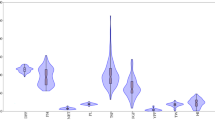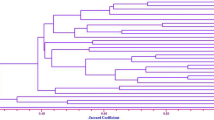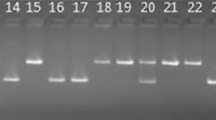Abstract
Upland rice production plays an important role in both household consumption and crop rotation. Until now, a blast resistant upland variety has not been released in Thailand. The bimodal pattern of rain distribution in Thailand’s upland rice production areas create a favorable environment for the outbreak of leaf blast when seedling-tillering, and neck blast within the heading stage. The use of genetically resistant cultivars has proven to be an effective way to cope with this problem. In this study, 256 indigenous upland rice plants were screened for blast resistance under greenhouse and field conditions. Ten indigenous upland rice varieties, ULR292, ULR242, ULR219, ULR162, ULR161, ULR134, ULR109, ULR098, ULR081, and ULR066, were identified as resistant to leaf blast disease in both natural infection and artificial inoculation, under greenhouse conditions. Additionally, six of the ten varieties, ULR162, ULR161, ULR134, ULR109, ULR098, and ULR081, were found to be resistant to neck blast under field conditions. These new sources of blast resistance identified from indigenous upland rice varieties proved more resistant than the check varieties, depicting their potential for further use in Thailand’s rice blast resistance improvement program.




Similar content being viewed by others
References
Aram P, Nadali BJ, Nadali B, Gorbanali N (2013) Leaf blast resistance of rice different genotypes in blast nursery. Int J Agric Crop Sci 5:1307–1313
Arshad HMI, Khan JA, Jamil FF (2008) Screening of rice germplasm against blast and brown spot disease. Pak J Phytopath 20(1):52–57
Ballini E, Nguyen TTT, Morel JB (2013) Diversity and genetics of nitrogen induced susceptibility to the blast fungus in rice and wheat. Rice 6:1–13
Castano JB, Amril B, Syahril D, Zaini Z (1990) Upland rice genotypes resistance to blast (B1) disease in west Sumatra. Int Rice Res Newslet 15:11–12
Chang TT (1976) The origin, evolution, cultivation, dissemination and diversification of Asia and African rice. Euphytica 25:425–441
Chauhani JS, Variar M, Shukla VD, Maiti D, Bhattacharya N, Lodh SB (2000) Screening rice genetic resources for major diseases of uplands and quality. Indian Phytopath 53:80–82
Chen X, Shang J, Chen D, Lei C, Zou Y, Zhai W, Liu G, Xu J, Ling Z, Cao G, Ma B, Wang Y, Zhao X, Li S, Zhu L (2006) A B-lectin receptor kinase gene conferring rice blast resistance. Plant J 46(5):794–804
Chin KM (1994) Collar rot, a new symptom of the rice blast disease. MARDI Res 2:82–84
Dai Y, Jia Y, Correll J, Wang X, Wang Y (2010) Diversification and evolution of the avirulence gene AVR-Pita1 in field isolates of Magnaporthe oryzae. Fungal Genet Biol 47(12):973–980
Dar SH, Rather AG, Najeeb S, Ashraf AM (2015) Screening of rice germplasm against blast disease under temperate conditions. Mol Plant Breed 6:1–4
Eamchit S, Mew TW (1982) Comparison of virulence of Xanthomonas campestris pv. oryzae in Thailand and the Philippines. Plant Dis 66:556–559
Faivre-Rampant O, Bruschi G, Abbruscato P, Cavigiolo S, Picco AM, Borgo L (2011) Assessment of genetic diversity in Italian rice germplasm related to agronomic traits and blast resistance (Magnaporthe oryzae). Mol Breed 27:233–246
Faivre-Rampant O, Geniès L, Piffanelli P, Tharreau D (2013) Transmission of rice blast from seeds to adult plants in a non-systemic way. Plant Pathol 62:879–887
Ghazanfar MU, Habib A, Sahi ST (2009) Screening of rice germplasm against Pyricularia oryzae the cause of rice blast disease. Pak J Phytopath 21:41–44
Hoque ME, Mansfield JW (2005) A simple and reliable method for pathogenicity tests of bacterial disease of rice. Bangladesh J Bot 34:11–16
IRRI (1998) Standard evaluation system for rice, 3rd edn. International Rice Testing Program, International Rice Research Institute, Manila
IRRI (2002) Standard evaluation system for rice (SES). International Rice Research Institute, Los Banos
Jongdee B, Pantuwan G, Fukai S, Fischer K (2004) Improving drought tolerance in rainfed lowland rice: an example from Thailand. New directions for a diverse planet. In: Proceedings of the 4th international crop science congress, 26 Sep–1 Oct 2004, Brisbane, Australia, p 14. www.cropscience.org.au. Accessed 21 Feb 2017
Joshi BK, Hari Bim P, Gopal P, Bedanand C (2009) Molecular tagging, allele mining and marker aided breeding for blast resistance in rice. BSN E-Bull 1:1–23
Liang Y, Yan B, Peng Y, Ji Z, Zeng Y, Wu H, Yang C (2017) Molecular screening of blast resistance genes in rice germplasms resistant to Magnaporthe oryzae. Rice Sci 24:41–47
Maclean DC, Dawe DC, Hardy B, Hettel GP (2002) Rice almanac: source book for the most important economic activity on earth, 3rd edn. CABI Publishing, IRRI, Los Baños
Maclean J, Hardy B, Hettel G (2013) Rice almanac: source book for the most important economic activities on earth, 4th edn. GRiSP (Global Rice Science Partnership) IRRI, Los Baños
Mei C, Qi M, Sheng G, Yang Y (2006) Inducible overexpression of a rice allene oxide synthase gene increases the endogenous jasmonic acid level, PR gene expression, and host resistance to fungal infection. Mol Plant Microbe Interact 19:1127–1137
Miah G, Rafii MY, Ismail MR, Puteh AB, Rahim HA, Asfaliza R (2013) Blast resistance in rice: a review of conventional breeding to molecular approaches. Mol Biol Rep 40:2369–2388
Office of Agriculture Economics (2015) Agricultural statistics of Thailand 2015. Annual report of 2015. Ministry of Agriculture and Cooperatives, Bangkok, Thailand, p 240
Samiullah RA, Salman M, Sarwar M, Umar A, Hussain A, Habibullah NM, Hussain SM, Ayatullah MN, Akbar I (2015) Evaluation of indigenous rice germplasm for resistance to bacterial blight and yield performance. J Entomol Zool Stud 3:449–453
Shafaullah, Khan MA, Khan NA, Salim-il-Yasin, Mahmood Y (2011) Response of rice germplasm to blast disease under field conditions. Pak J Phytopath 23(1):52–55
Sharma B, Pandey MP (2012) Identification of rice germplasm with resistance to bacterial blight (Xanthomonas oryzae pv. oryzae). Bangladesh J Agric Res 37:349–353
Sharma TR, Rai AK, Gupta SK, Vijayan J, Devenna BN, Ray S (2012) Rice blast management through host-plant resistance: retrospect and prospect. Agric Res 1:37–52
Tanweer FA, Rafii MY, Sijam K, Rahim HA, Ahmed F, Latif MA (2015) Current advance methods for the identification of blast resistance genes in rice. C. R. Biol 338:321–334
Titone P, Mongiano G, Tamborini L (2015) Resistance to neck blast caused by Pyricularia oryzae in Italian rice cultivars. Eur J Plant Pathol 142:49–59
Variar M, Vera CCM, Carrillo MG, Bhatt JC, Sangar RBS (2009) Rice blast in India and strategies to develop durably resistant cultivars. In: Xiaofan W, Valent B (eds) Advances in genetics, genomics and control of rice blast disease. Springer, New York, pp 359–374
Vasudevan K, Vera Cruz CM, Gruissem W, Bhullar NK (2014) Large scale germplasm screening for identification of novel rice blast resistance sources. Front Plant Sci 5:1–9
Vasudevan K, Gruissem W, Bhullar NK (2015) Identification of novel alleles of the rice blast resistance gene Pi54. Sci Rep 5:1–11
Wang R, Fang N, Guan C, He W, Bao Y, Zhang H (2016) Characterization and fine mapping of a blast resistant gene Pi-jnw1 from the japonica rice landrace Jiangnanwan. PLoS ONE 11(12):e0169417
Xin X, Hayashi N, Wang CT, Fukuoka S, Kawasaki S, Takatsuji H, Jiang CJ (2014) Rice blast resistance gene Pikahei-1(t), a member of a resistance gene cluster on chromosome 4, encodes a nucleotide-binding site and leucine-rich repeat protein. Mol Breed 34:691–700
Acknowledgements
This research was supported by the Plant Breeding Research Center for Sustainable Agriculture and Research Center of Agricultural Biotechnology for Sustainable Economy, Khon Kaen University, Khon Kaen, Thailand; and the Ubon Ratchathani Rice Research Center (URRC). Our gratitude is also extended to the Thailand Research Fund (TRF) (Project Code: IRG5780003) and Khon Kaen University’s Faculty of Agriculture for providing financial support for the manuscript preparation.
Author information
Authors and Affiliations
Corresponding author
Electronic supplementary material
Below is the link to the electronic supplementary material.
Rights and permissions
About this article
Cite this article
Chumpol, A., Chankaew, S., Saepaisan, S. et al. New sources of rice blast resistance obtained from Thai indigenous upland rice germplasm. Euphytica 214, 183 (2018). https://doi.org/10.1007/s10681-018-2267-3
Received:
Accepted:
Published:
DOI: https://doi.org/10.1007/s10681-018-2267-3




